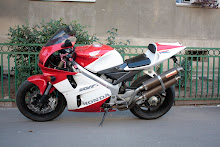The Honda RVF400R was the successor to the VFR 400 NC30 which ceased production in 1992. While at first glance there appear to be mainly styling changes between the VFR 400 and the RVF400R, the actual number of changes are vast as the entire bike was redesigned with numerous identical looking components being totally different.
The obvious differences between the VFR 400 and the RVF400R are that the front forks are of the upside-down type and the rear wheel takes a 17" tyre (the VFR 400R took a 18"), there are two air tubes that feed fresh air to the area just in front of the air box (this is not a ram air system, the airbox is unpressurised) and the headlights have changed from twin round headlights to twin 'fox-eye' lights (this is one feature not mirrored from the RVF750 RC45 as the RC45 features twin large round headlights).
Unlike the VFR400 NC30, the RVF400R was only officially sold new in Japan. The RVF400R outputs slightly less peak power than the VFR400R, but with a stronger midrange. There is a Haynes Manual for the RVF400R.
Like other Hondas with gear-driven camshafts, the RVF's engine makes a loud 'whine' sound when operating. The exhaust note of the V4 engine is also different from that of a more conventional inline four. The 400 cc VFR and RVF models share a unique exhaust note with their larger siblings -- the VFR750R RC30 and the RVF750R RC45 -- because of their 360-firing configuration. Most of the early V4s from Honda were 360-firing. Some examples include the VF500C/F, VF750/VF1100 C/S, VF750F/VF1000F. The VF1000R was Honda's first road-going 360-firing, gear-driven cam engine.
The RVF400R has a reputation for excellent reliability and good build quality, though not quite as high as its predecessor, the VFR400R
The NC35 was built and/or sold as new by Honda dealers in Japan from 1994 to sometime in 2000 (possibly later). It was obviously an evolution of the popular NC30, but its purpose was similar to the NC30's purpose of making a "junior" RC30 available to the vast Japanese 400cc domestic market, but with respect to the then-new 750cc RC45 superbike. (Why Honda didn't just call it the "NC45" is still a mystery, however!) But, unlike the RC45's changes compared to the RC30, the NC35 did not use fuel injection or a completely redesigned engine—it's engine is a re-tuned NC30 engine with slightly smaller carburetors. In any case, there were several other significant differences between the NC30 and NC35 models apart from different bodywork, including engine mounting, fork type, swing arm width and 17" rear wheel. (Click here for a Web site with a graphic display of some of the differences touted by Honda upon the release of the NC35.
"NC35" is not the official name for the bike Honda designated the "RVF400R" (and later simply "RVF"), but this is how they are commonly known. As far as we are aware, Honda built only domestic ("J-spec") models of the RVF400R. But NC35s were so popular in Japan that they quickly overflowed and found their way (as "grey imports") into the United Kingdom and, in much smaller numbers, into other markets—including the United States. The NC35 stayed basically the same throughout its model run, except for a color change between the RR and RT models. (A complete list of non-color-related part numbers changed for the R-T model is located here.) Even though available new in Japan for many years thereafter, the NC35's specs remained essentially unchanged since 1996. Below are illustrations of the two (and only two) NC35 color schemes:



Niciun comentariu:
Trimiteți un comentariu